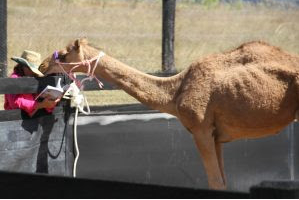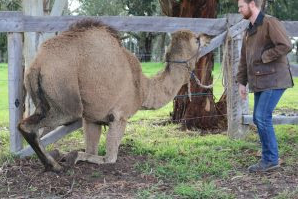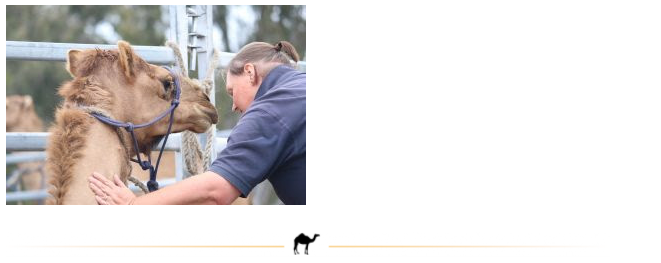3 Tips to Understanding Your Camel Better
Sep 08, 2021You can read below or if you like doing more than two things at once you can listen to the audio below...
It’s very common practice on our camel farm to find ourselves hanging out in the camel paddocks, not doing anything in particular, just hanging’ with our camels. Our camel herd feel so comfortable with us that they treat us like one of their own, it’s a really cool feeling. We often catch ourselves thinking “heck, are we becoming a camel!?” So what if we are, if we reincarnate, we want to come back as a camel!
So, how can YOU learn to understand your camel(s) better?
More importantly lets first look at the WHY.
Why is it important for you to understand your camel better?
As you probably know Camel’s are widely misunderstood in our world. Ask the next person you see “what are camels like” and more than likely you will hear the words ‘temperamental, spitting, biting creatures.’ Yet you’ll find most people haven’t even been near a camel! It’s only what the media portrays or some really poor camel handling skills, hence why you need to understand your camel better. Learning to understand your camel better will put you way ahead in your camel management, camel training and camel handling skills. The KEY to owning a camel and training a camel – we think – is to know them inside out. Camel’s may be hairy and cute on the outside, but what about their inside - their ‘soul’ and their makeup? Also, we need to add, that every camel has it’s unique personality traits, therefore spending time with each individual camel is so important. You will begin to notice similar character traits (more instinctual than anything) between camels, but ultimately every camel has it’s own personal makeup.
Let’s explore some ways that you can learn to understand your camel(s) better with these three tips...
3 Tips to Understanding Your Camel Better
1. Hang out with your camel. In our modern world we know how time consuming a lot of things are. Money is Time, Time is Money etc. One thing a camel will most certainly teach you is to ‘live in the moment’ – we call this “Camel Time.” So, go out to their paddock/yard area and just hang with them. Don’t do anything, don’t encourage contact, just be there and witness their fascinating quirks, what they eat, how they interact with their environment and or other animals in that paddock. You’ll learn a lot from this simple exercise. If you can spend a few hours, take a book to read (this one might suit the occasion) and let them figure you out and you them. Enjoy it. I’m sure it won’t be hard to convince you to spend more time with your camel or even if you don’t have any camels yet to spend anytime, anywhere in their presence. The most skilled camel handlers (cameleers) see the value in being in the camels presence. Not doing anything or being anything, just simply in their presence.
Being in camel's presence
2. Camel Training Sessions It may seem obvious, but spending some training time with your camel will most certainly improve your understanding of them and them of you. You will learn what they like, what they dislike, what type of energy they prefer to be around (e.g. calm and gentle) and the difference when your energy is a bit more high strung. You cannot train a camel when you are feeling high strung, anxious or they like. It just goes against every essence of the camel and their being. You will learn what sort of touch they prefer and their comfort level. These things may seem really obvious, but once you start training and handling camels you will soon discover that this is way more complex than you first thought. If you are training and find yourself getting frustration, the camel is getting frustrated, everything is getting heated, the best thing you can do is walk away (if the camel is tied up, it will be okay for a few minutes). This will allow time for the ‘heat’ to disperse and you and the camel to gather your thoughts. This does NOT mean that the camel is getting away with any ‘bad behavior’ or whatnot, camels function differently to what you might think. Like we said above, you cannot train camels when your are highly strung, anxious or the like. It goes against every essence that makes up the camel. Trust us – we’ve been there!
Camel Training & Handling sessions
3. Touch. Let them touch you without any bribery, food and treats. If they are wild and untrained only let THEM touch you. Build that trust before you reach out a hand and step over that boundary. That time will come. Camels are very curious creatures and this is how they learn best especially when trained in a Trust Based way. If your camel is used to touch and contact with you, stroke around the body in a calm and gentle way. No patting (slapping), patting is not a natural feel to a camel, in fact they generally hate it or tolerate it. Similar thing can be said for scratching camels in places where they seem to like it. A couple of things about ‘scratching’ a camel (e.g. behind the ear or under chin). Camel’s grow – really big! The last thing you want is a grown camel leaning into you for a scratch. If the camel wants a scratch they will find something to scratch on a human should not be one of those things. It’s more a boundary thing than anything else. If you think about when a camel does scratch, they don’t care about that pole or tree that they are scratching on, all they know is it feels good to them. The camel won’t think anything more of you on a personal level if you scratched them.
Camel’s enjoy long, firm but light strokes on the body. If you trust your camel and your camel you, stoke them all over the body. If you’ve taught your camel to sit or “hoosh” ask them to sit and stroke all over. Get out any prickles or other amazing things that managed to have gotten caught up in their (winter) wool. Camels think this as a massage and at the same time you are teaching your camel to understand that you are not to be feared by them. You will also gain confidence around your camel(s) as you look for and observe their signs of likes and dislikes and most importantly how to compose yourself while being around them. Some camels might need lighter touches than others, while some other camels like to be touched/stroked more firmly.
To sum it up.
3 ways to understanding your camel better:
1. Hanging out with your camel(s) or if you don't own camels yet observe them on media or any camels that are in your local area and the like.
2. Camel training and camel handling sessions will put you way ahead with your camel skills and knowledge.
3. Touching your camel. Asking for that permission to be allowed into their world through trust and acceptance.
Most importantly, enjoy your time with camels, they are amazing creatures!
Get Your Free Copy:
Introduction to Camels eBook
We hate SPAM. We will never sell your information, for any reason.






